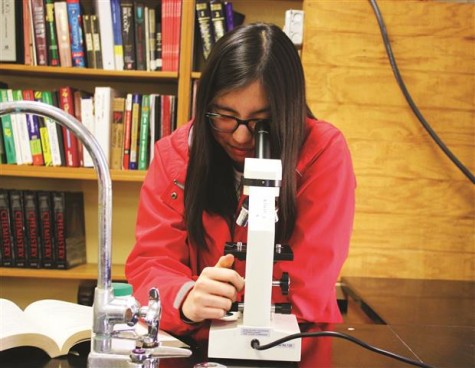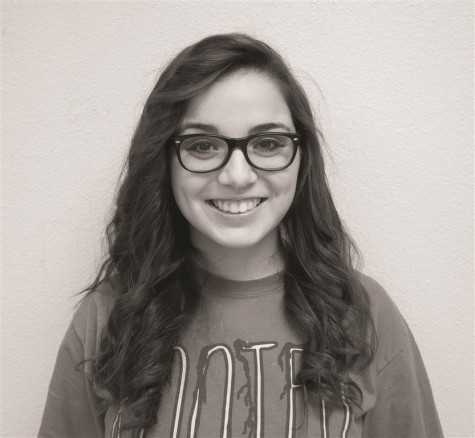As the days of summer were coming to an end, senior Lyndie Ho found herself at the University of Texas at Dallas in Richardson. Over the past couple of months, she had spent eight to ten hours a day at a lab in UTD as a part of the university’s George A. Jeffrey NanoExplorers Summer Program.
After pairing the students who were accepted into the program with some of the school’s professors at the beginning of the summer, they worked in that m ember’s lab on original research throughout the summer. Now, students and professors from other labs as well as many from her own gathered together to listen to the eight presentations that were planned for the day, including Ho’s neural probe project.
ember’s lab on original research throughout the summer. Now, students and professors from other labs as well as many from her own gathered together to listen to the eight presentations that were planned for the day, including Ho’s neural probe project.
“I got really good feedback on my presentation from professors that were outside of my lab, and that felt really good to know [that] the people within my lab think my work is valuable and other people do also,” Ho said. “It’s nice to know that you’re being appreciated outside of your own field.”
The project that consumed her summer focused on developing a new type of neural probe that would treat disorders like Alzheimer’s and the effects of strokes. According to Ho, many of these disorders are not caused by physical damage to the brain, but by chemicals traveling to the wrong areas of the brain.
Essentially, planting these probes into neural tissue would assist in redirecting these chemicals to their appropriate destinations and minimize side effects. When Ho learned this, it reminded her of her grandmother’s post-stroke recovery struggles.
“When I learned that it’s not a part of her brain that’s broken, it’s something as simple as the chemicals in her brain are not going the right way, then I thought that was really interesting that you could just make them go the right way,” Ho said.
Currently, neural probes that can assist people like Ho’s grandmother exist, but are made with hard materials that are not as compatible with the tissue. The goal of her research over the summer was to develop plastics for probes that could be implanted both into neural tissue and other areas of the body like spinal implants to aid paralysis and cochlear implants to assist hearing impairments.
“It’s not great for the body to have things that are really hard inside it,” Ho said. “The goal is to make a plastic that is soft, but you don’t want to have a plastic that is so soft that when you try to insert it, it just bounces off.”
Ho has handed over some of the project to the graduate students she worked with over the summer since starting school. She is now focused on developing various new types of plastics. While the research has been a large undertaking, Ho attributes her mental growth to the support provided to her by the university. Not only was she matched with a professor, but she also received an undergraduate and a graduate student mentor.
“I think the main issue in any project is just getting it off the ground, but I had a lot of help because the NanoExplorers program is really great at matching you with professors who are very established,” Ho said. “They know what they’re doing.”
During orientation for the NanoExplorers program, Ho visit-ed various tables in the university’s conference room. Professor after professor and graduate student after graduate student spent time discussing their projects with Ho and her peers.
As she tried to discern where she would best fit in, she found herself returning to the first group of graduate students she spoke to that day. The project didn’t require some of the prerequisites that others did, and she would be able to work individually, rather than with a group. One of those students, Radu Reit, even became a type of mentor to Ho who oversaw her research along with Haley Abitz, an undergraduate student who worked virtually everyday by Ho’s side.
“One nice thing about that experience is that you immediately got to see your professor and your grad students’ personalities and you could figure out if you mesh well with them,” Ho said.
This type of work is what Ho says she aspires to do with her life. Originally she wanted to become a doctor, but she quickly discovered that such a career may not be the best choice for someone who gets squeamish around blood. Her time and hands on experience in the lab has enabled her to discover another way she can make a difference.
“This is a nice halfway point where… I don’t have to dissect bodies and stuff like that but I still get to do things that help people in medicine, so I think this is what I want to do,” Ho said.
Her new connections in the lab are not only helpful to her research, but she hopes they will also help her achieve future goals.
Ho says she is leaning towards attending Stanford Univer-sity. Since she is working with a lot of graduate students who obtained under-graduate educa-tion elsewhere, some even at Stanford, she is hoping to get connected with similar research projects in college.
Despite the research opportunities she has received, Ho says she attributes this success more to her hard work than natural talent.
She encourages students interested in any field to take the initiative to seek out opportunities like the NanoExplorers program. A simple Google search she says could produce similar opportunities for other students.
“I think that anyone who was motivated could do the same thing that I could,” Ho said. “I wish that more people knew about internships at UTD and stuff like that because I think that a lot of people probably want to do stuff like this, and they aren’t aware of the opportunities that are around us.”






